March’s Monthly Mushroom: Frosty Bonnet (Mycena tenerrima)

There are not many signs of mushrooms about at the moment, as we transition to a time of emergent Spring greens and Monty Don back on telly. Resupinates continue to flourish in the dank places beneath logs, while the remnants of certain brackets persist on trunks and stumps. Nevertheless, aside from a few notable exceptions, like St. George’s Mushrooms or Morels, there won’t be many of the more obviously mushroom-shaped fungi around over the coming few months.
Rest assured however, the various species are still doing their bit, out of site and out of mind, their mycelia recycling nutrients, turning plant litter to topsoil, and breaking up the tough fibres in dead wood and other plant debris so that the worms, insects and other critters can move in to carry on the job, before they burst back to manifest themselves visibly again in the form of reproductive fruiting bodies later in the year. I mention this because, during a trip to my favourite woodland at the beginning of January, I couldn't help but notice a considerable amount of tidying up had been going on. Granted, much of it was necessary – specifically the fallen bough obstructing the public right of way passing through it – although arguably a trifle overzealous. One wondered what might have happened to the cleared logs and branches. Perhaps they ended up on a bonfire.
It would be a shame if this were the case. As Pat O’Reilly points out in his Fascinated by Fungi book, “a lot of carbon is locked up in the world’s forests. We can either store it there in benign form … or release their carbon into the atmosphere as carbon dioxide and other greenhouse gases that blanket the earth and prevent surface heat escaping into space.” A lot of water is stored in trees (be they living or dead) too, and so leaving unwanted wood to rot where it falls, or at least piling it up in a more convenient out-of-the-way place, is a good way of keeping this carbon, moisture and whatever other minerals and nutrients within the more local ecosystem rather than dispersing it off into the atmosphere as smoke.
If it is forest maintenance you are looking at, there are plenty of organisms around that can make use of unwanted wood, many already existing within it. On the obstructing fallen branch I mentioned, for example, I had a few months before discovered a number of fruiting bodies of some of the tinier members of the genus I am going to zero in on in this post, the Mycena. I didn’t recognise the particular type, but if the branch were chopped up and burnt as feared, then that individual specimen would have certainly gone up in smoke with it and I won’t be seeing it again this Autumn.
We will no doubt all have seen examples of this large grouping known commonly as Bonnet mushrooms. I ended last month’s post mentioning the miniscule Beechleaf Bonnet (Mycena capillaris), which I was only able to find as my eye was already fixed at ground level looking at something else. But many are considerably more conspicuous.
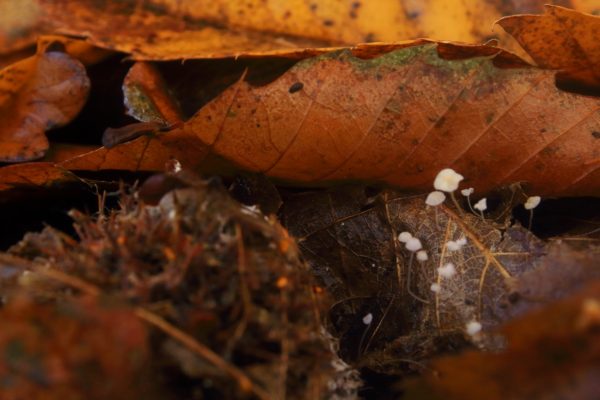
Beechleaf Bonnet (Mycena capillaris)
The Common Bonnet (Mycena galericulata), regularly spotted in groups on well-decayed logs and stumps and surrounded by moss, gets up to 7cm in cap diameter, for example. The cap of another that associates with moss and crumbling wood, the more delicate-looking Angel’s Bonnet (Mycena arcangeliana), reaches up to 3cm across and sits atop a slender stem of up to 8cm long: the iodine whiff when you sniff it is one of the keys to its identification.
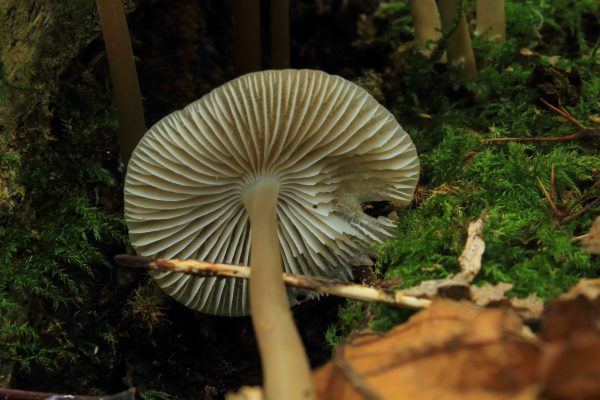
Probably, but not certainly Angels Bonnet (Mycena arcangeliana) - underside
The Milking Bonnet (Mycena galopus) is of similar dimensions but distinguishable in as much it favours leaf and needle litter rather than rotten wood to grow and feed within and, more definitively, its stem exudes a milky latex when broken.
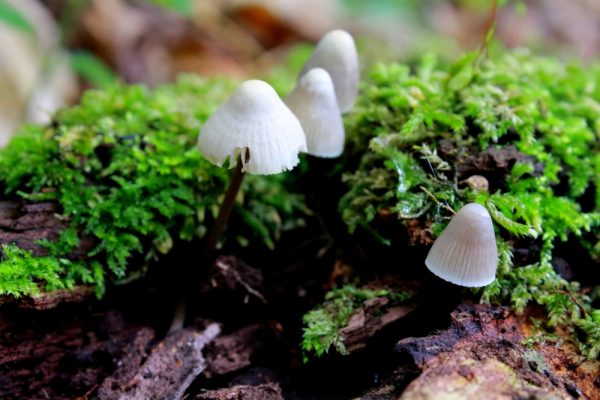
Milking Bonnet (Mycena galopus)
Striated caps are a feature of many a Mycena, but in the Grooved Bonnet (Mycena polygramma) they run down the stalk too.
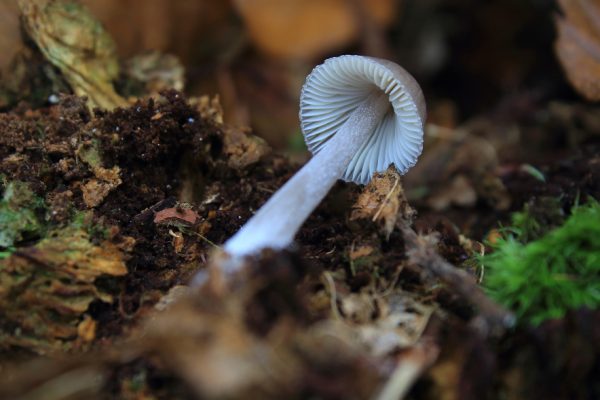
Grooved Bonnet (Mycena polygramma)
Confusingly, colour isn’t much to go on with these more common types. There are two variants of the grey-brown Milking Bonnet: the white Mycena galopus var candida and the black Mycena galopus var nigra. The other aforementioned species also waver between ivory white to pale grey to brown depending on age and whether it has been raining or not.
Similarly frustratingly, the grey-brown Clustered Bonnet (Mycena inclinata) is not the only one to grow in clusters.
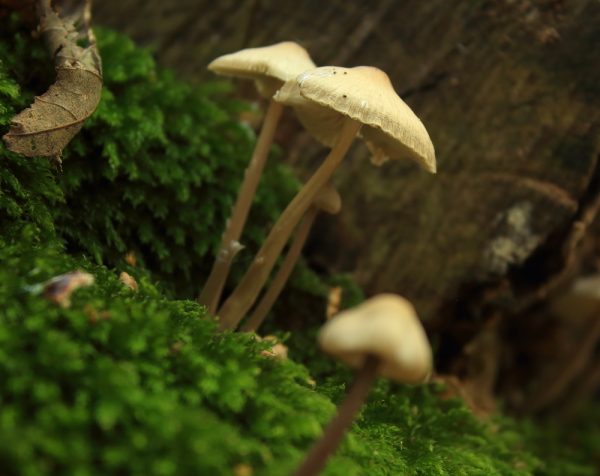
Could be either Angels Bonnet (Mycena arcangeliana) or Clustered Bonnet (Mycena inclinata)
One relatively easy one to identify is the Ivory Bonnet (Mycena flavoalba), a small grassland species found in parks and lawns with an ivory cap, about 1-2cm across and yellowing towards the raised ‘umbo’ centre, that starts out bell-shaped before turning upwards and becoming wavy at the margins.
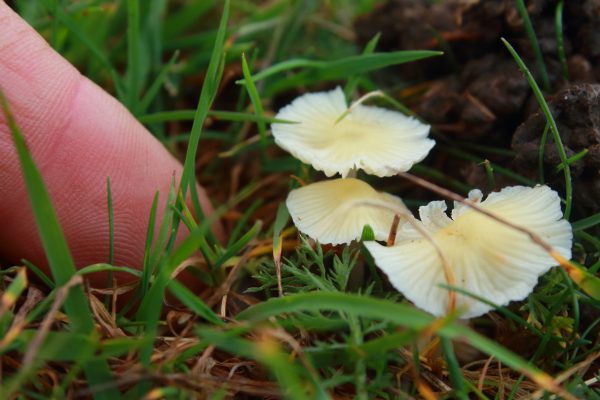
Ivory Bonnet (Mycena flavoalba)
These are, however, but a small selection of the currently estimated 500 species of Mycena. According to the 1994 edition of Roger Phillips’ Mushrooms and Other Fungi of Great Britain & Europe that I own, there are “one hundred and two in Britain” and no doubt a few more have been discovered since then.
To be honest, my feeling towards Mycena is not dissimilar to your typical LBMs (“Little Brown Mushrooms”). You could spend an infinite amount of time tying yourself up in knots trying to identify the exact species you have found, but in most cases that way madness lies. Perhaps it is enough at least knowing when you have found a Mycena, as opposed to other similar small pale-beige-to-grey-brown bell-shaped mushrooms that grow on rotten tree stumps in large groups.
A small conical or campanulate cap and a thin stem with no ring on it will get you so far, but the main identifying feature of Mycenae are the white spores: take a specimen home, lay the cap face down on black paper for a few hours and if it leaves a white spore print, you are on your way. By contrast, something like the similar-looking Fairy Inkcap (Coprinellus disseminatus) has black gills and spores.
If you have a microscope, the spores themselves might also provide further clues, as well as other otherwise invisible details such as the cystidia (the cells on the edge of the gills from which the spores are released), providing you have something suitable to reference it against: Pat O’Reilly’s First Nature site is a great resource in this respect.
Mycena can be found from early Summer through to late Winter, and there may indeed even be some around at the moment, with the seasons so off-kilter these days. All are saprotrophic / saprobic, meaning they work on decaying on wood, leaves, pine needles or other organic matter, and as such play a vital part within their given ecosystem.
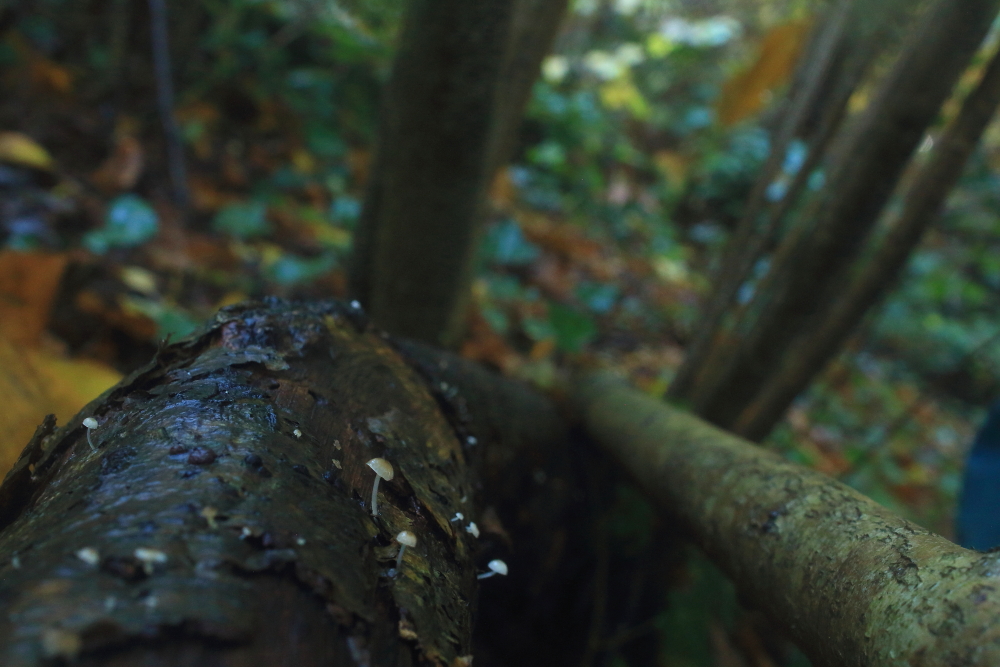
Bonnet on fallen tree trunk
The substrate is one of the clues assisting you pinpoint what you might have found. Even if you can’t put a name to them, Mycena in general are very attractive, very photogenic mushrooms, but some are absolutely tiny, the reproductive fruiting bodies less than a millimetre across, and will definitely require a macro lens to get a decent photo and a hand lens just to get a proper look.
I wouldn't have a clue where to begin going about identifying most of these: my Beechleaf Bonnet (Mycena capillaris) might indeed not even have been that. Some kind soul in the British Mycological Society Facebook group claimed it could equally be M. polyadelpha, a species without a common English name that looks about the same but favours oak leaf litter, though also can be found on beech. The Beechleaf Bonnet (Mycena capillaris) is not tied to beech either, but any broadleaf litter, and I actually found it in a chestnut wood. Neither of these species, presumably just too small to provide illustrative photos of, are listed in the relatively small selection of Mycena in the otherwise comprehensive Phillips or Jordan books I’ve already mentioned in this post.
Naturally taking a spore print of something this minute presents its own problems, but other things you might like to check out are what does it smell like and what does the base of the stem look like where it is attached to a wood substrate? Is its base bulbous, furry or both? How are the gills attached to it? What does the surface of the cap look like? Is it covered in tiny hairs or granules?
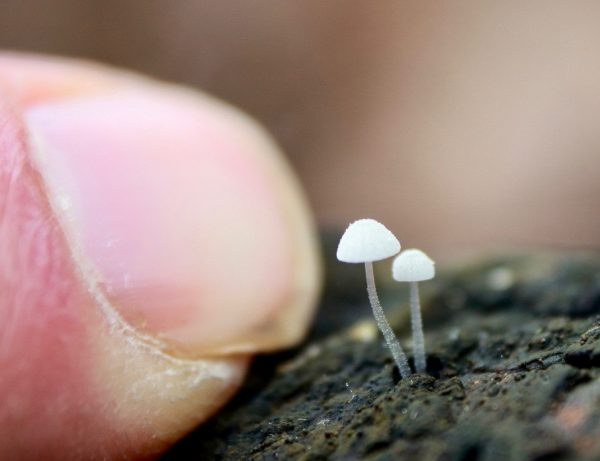
Frosty Bonnet (Mycena adscendens)
Fortunately there was enough evidence on the photo of another species included just above here for mycological maestro Richard Shotbolt to pinpoint my posting on the British Mycological Society page in December here as the Frosty Bonnet (Mycena adscendens, also M. tenerrima). It is one of the few distinctive and common enough to warrant its own Wikipedia entry and is distinguished by a cap “dusted with sugar-like granules” and a stem “set on a disc-like base”.
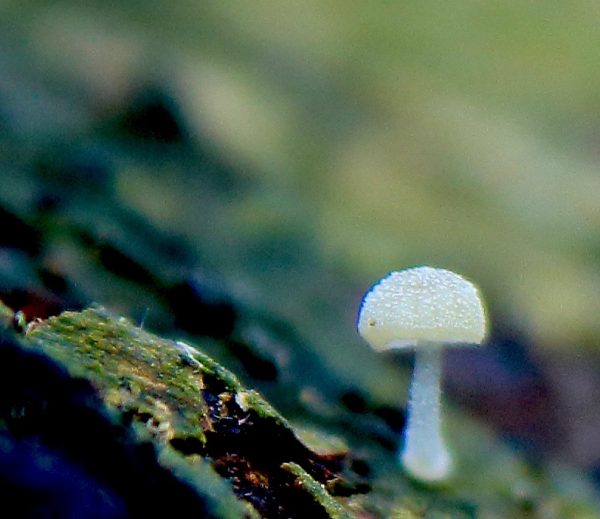
"“dusted with sugar-like granules"
So flushed with excitement was I (both by my photo and someone being able to put a name to it) that I’ve decided to make the Frosty Bonnet March’s Monthly Mushroom. I’ve no idea whether they can be found at the moment, but I do know that you’ll have to hunt pretty hard to find one. There’s no mention of the Frosty Bonnet in any of the printed literature I have, and not much online either, an indication of how, like the resupinates mentioned in January, Mycena really present one of the final frontiers for only the most hardcore mycophiles.
If this is a path you wish to travel, the definite book is The Genus Mycena: Fungi of Northern Europe vol. 5 , compiled by Arne Aronsen and Thomas Læssøe. Michael Kuo provides a nice introduction to the subject on Mushroomexpert.com complete with a handy key for North American species, and there’s also a pretty exhaustive list of specimens within this ‘genus of bonnet toadstools’ on the website BioInfo: food webs and species interactions in the Biodiversity of UK and Ireland . Happy hunting!
Comments are closed for this post.

Hello, I took a photograph of a white speck (1-2mm) on a dying Damson trunk. I was checking to see if it was a butterfly egg but it turns out it is a very tiny mushroom. I think it might be a frosty bonnet. Your photograph is the closest I have seen. I will look at your suggested websites. Thank you.
Clare Seymour
6 February, 2021